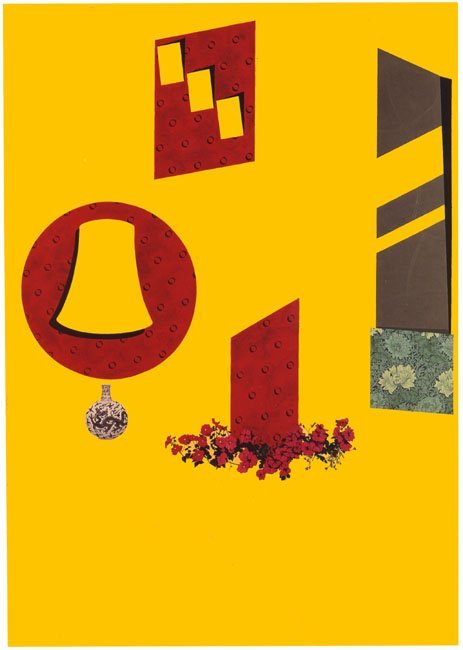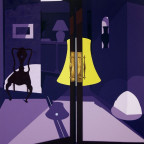Biography
Eight works in the exhibition are large paintings of interiors such as ‘Lunch-time’ 1985 and ‘Terrace’ 2002. He made his first interior paintings at the end of the 1960s and they have remained a constant theme in his work. He depicts anonymous public places; a hotel room, reception area or restaurant, often empty of people. These paintings are life-size in their representation and incorporate ordinary objects from our daily lives such as plants, drinking glasses, bottles, tables and lamps. Caulfield has stated: ‘If I am dealing with an interior I think of something I want to do, something realistic, and I start with the feeling of the space it is in. The reason I do some parts of the painting real, is to make the other things real by interpretation.’ Marco Livingstone has written of the works in the exhibition: ‘they reveal a striking consistency in Caulfield’s ostensible subject-matter, formal assurance, technical brilliance and pictorial wit. But they display with no less conviction, a constant desire to reinvent the terms of his art, to find new solutions for old pictorial problems and to pare down his language towards a greater apparent starkness without sacrificing any of the sophisticated intricacy with which he depicts things in space on a flat surface.’
Although Caulfield uses his motifs sparingly, the works as a whole are complex in terms of their combination of images, composition and technique. Five works on board that will be exhibited, of identical size completed this year display an economy of form: these works are all painted on a monochromatic ground with the most simple of forms in rich colour. Like the paintings of pipes from the early 90s (three of which will be in the exhibition) these new works include geometric shapes of card that are stuck onto the surface of the board. Six pencil drawings will also be on show which are from a set of 32 ‘Lamp Studies’ made in 1991.
继续作品
-
 Patrick Caulfield, Glass of Whisky, 1987
acrylic on canvas
30 x 44 in / 76.2 x 111.8 cm
%3Cdiv%20class%3D%22artist%22%3E%3Cstrong%3EPatrick%20Caulfield%3C/strong%3E%3C/div%3E%0D%3Cdiv%20class%3D%22title%22%3E%3Cem%3EGlass%20of%20Whisky%3C/em%3E%2C%201987%3C/div%3E%0D%3Cdiv%20class%3D%22medium%22%3Eacrylic%20on%20canvas%3C/div%3E%0D%3Cdiv%20class%3D%22dimensions%22%3E30%20x%2044%20in%20/%2076.2%20x%20111.8%20cm%3C/div%3E
Patrick Caulfield, Glass of Whisky, 1987
acrylic on canvas
30 x 44 in / 76.2 x 111.8 cm
%3Cdiv%20class%3D%22artist%22%3E%3Cstrong%3EPatrick%20Caulfield%3C/strong%3E%3C/div%3E%0D%3Cdiv%20class%3D%22title%22%3E%3Cem%3EGlass%20of%20Whisky%3C/em%3E%2C%201987%3C/div%3E%0D%3Cdiv%20class%3D%22medium%22%3Eacrylic%20on%20canvas%3C/div%3E%0D%3Cdiv%20class%3D%22dimensions%22%3E30%20x%2044%20in%20/%2076.2%20x%20111.8%20cm%3C/div%3E -
 Patrick Caulfield, Reception, 1988
acrylic on canvas
120 x 81 in / 304.8 x 205.7 cm
%3Cdiv%20class%3D%22artist%22%3E%3Cspan%20class%3D%22artist%22%3E%3Cstrong%3EPatrick%20Caulfield%3C/strong%3E%3C/span%3E%3C/div%3E%0D%3Cdiv%20class%3D%22title%22%3E%3Cem%3EReception%3C/em%3E%2C%201988%3C/div%3E%0D%3Cdiv%20class%3D%22medium%22%3Eacrylic%20on%20canvas%3C/div%3E%0D%3Cdiv%20class%3D%22dimensions%22%3E120%20x%2081%20in%20/%20304.8%20x%20205.7%20cm%3C/div%3E
Patrick Caulfield, Reception, 1988
acrylic on canvas
120 x 81 in / 304.8 x 205.7 cm
%3Cdiv%20class%3D%22artist%22%3E%3Cspan%20class%3D%22artist%22%3E%3Cstrong%3EPatrick%20Caulfield%3C/strong%3E%3C/span%3E%3C/div%3E%0D%3Cdiv%20class%3D%22title%22%3E%3Cem%3EReception%3C/em%3E%2C%201988%3C/div%3E%0D%3Cdiv%20class%3D%22medium%22%3Eacrylic%20on%20canvas%3C/div%3E%0D%3Cdiv%20class%3D%22dimensions%22%3E120%20x%2081%20in%20/%20304.8%20x%20205.7%20cm%3C/div%3E -
 Patrick Caulfield, Lounge, 1989
acrylic on canvas
114 x 81 in / 289.5 x 205.7 cm
%3Cdiv%20class%3D%22artist%22%3E%3Cspan%20class%3D%22artist%22%3E%3Cstrong%3EPatrick%20Caulfield%3C/strong%3E%3C/span%3E%3C/div%3E%0D%3Cdiv%20class%3D%22title%22%3E%3Cem%3ELounge%3C/em%3E%2C%201989%3C/div%3E%0D%3Cdiv%20class%3D%22medium%22%3Eacrylic%20on%20canvas%3C/div%3E%0D%3Cdiv%20class%3D%22dimensions%22%3E114%20x%2081%20in%20/%20289.5%20x%20205.7%20cm%3C/div%3E
Patrick Caulfield, Lounge, 1989
acrylic on canvas
114 x 81 in / 289.5 x 205.7 cm
%3Cdiv%20class%3D%22artist%22%3E%3Cspan%20class%3D%22artist%22%3E%3Cstrong%3EPatrick%20Caulfield%3C/strong%3E%3C/span%3E%3C/div%3E%0D%3Cdiv%20class%3D%22title%22%3E%3Cem%3ELounge%3C/em%3E%2C%201989%3C/div%3E%0D%3Cdiv%20class%3D%22medium%22%3Eacrylic%20on%20canvas%3C/div%3E%0D%3Cdiv%20class%3D%22dimensions%22%3E114%20x%2081%20in%20/%20289.5%20x%20205.7%20cm%3C/div%3E -
 Patrick Caulfield, Pipe & Blind, 1990
acrylic on canvas
30 x 24 in / 76.2 x 61 cm
%3Cdiv%20class%3D%22artist%22%3E%3Cspan%20class%3D%22artist%22%3E%3Cstrong%3EPatrick%20Caulfield%3C/strong%3E%3C/span%3E%3C/div%3E%0D%3Cdiv%20class%3D%22title%22%3E%3Cem%3EPipe%20%26%20Blind%3C/em%3E%2C%201990%3C/div%3E%0D%3Cdiv%20class%3D%22medium%22%3Eacrylic%20on%20canvas%3C/div%3E%0D%3Cdiv%20class%3D%22dimensions%22%3E30%20x%2024%20in%20/%2076.2%20x%2061%20cm%3C/div%3E
Patrick Caulfield, Pipe & Blind, 1990
acrylic on canvas
30 x 24 in / 76.2 x 61 cm
%3Cdiv%20class%3D%22artist%22%3E%3Cspan%20class%3D%22artist%22%3E%3Cstrong%3EPatrick%20Caulfield%3C/strong%3E%3C/span%3E%3C/div%3E%0D%3Cdiv%20class%3D%22title%22%3E%3Cem%3EPipe%20%26%20Blind%3C/em%3E%2C%201990%3C/div%3E%0D%3Cdiv%20class%3D%22medium%22%3Eacrylic%20on%20canvas%3C/div%3E%0D%3Cdiv%20class%3D%22dimensions%22%3E30%20x%2024%20in%20/%2076.2%20x%2061%20cm%3C/div%3E -
 Patrick Caulfield, Veranda, Mexico, 2002
acrylic on board
30 1/2 x 20 1/2 in / 77.5 x 52.1 cm
%3Cdiv%20class%3D%22artist%22%3E%3Cstrong%3EPatrick%20Caulfield%3C/strong%3E%3C/div%3E%0D%3Cdiv%20class%3D%22title%22%3E%3Cem%3EVeranda%2C%20Mexico%3C/em%3E%2C%202002%3C/div%3E%0D%3Cdiv%20class%3D%22medium%22%3Eacrylic%20on%20board%3C/div%3E%0D%3Cdiv%20class%3D%22dimensions%22%3E30%201/2%20x%2020%201/2%20in%20/%2077.5%20x%2052.1%20cm%3C/div%3E
Patrick Caulfield, Veranda, Mexico, 2002
acrylic on board
30 1/2 x 20 1/2 in / 77.5 x 52.1 cm
%3Cdiv%20class%3D%22artist%22%3E%3Cstrong%3EPatrick%20Caulfield%3C/strong%3E%3C/div%3E%0D%3Cdiv%20class%3D%22title%22%3E%3Cem%3EVeranda%2C%20Mexico%3C/em%3E%2C%202002%3C/div%3E%0D%3Cdiv%20class%3D%22medium%22%3Eacrylic%20on%20board%3C/div%3E%0D%3Cdiv%20class%3D%22dimensions%22%3E30%201/2%20x%2020%201/2%20in%20/%2077.5%20x%2052.1%20cm%3C/div%3E












